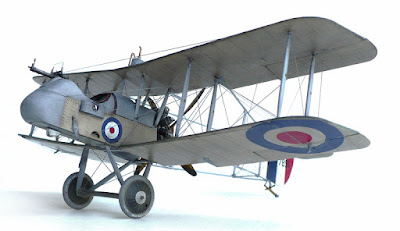Here are some images of Wingnut Wings 1/32 scale Airco DH.2 fighter.
From Wikipedia"
The Airco DH.2 was a single-seat biplane "pusher" aircraft which operated as a fighter during the First World War. It was the second pusher design by Geoffrey de Havilland for Airco, based on his earlier DH.1 two-seater. The DH.2 was the first effectively armed British single-seat fighter and enabled Royal Flying Corps (RFC) pilots to counter the "Fokker Scourge" that had given the Germans the advantage in the air in late 1915. Until the British developed a synchronisation gear to match the German system, pushers such as the DH.2 and the F.E.2b carried the burden of fighting and escort duties.
Early air combat over the Western Front
indicated the need for a single-seat fighter with forward-firing
armament. As no means of firing forward through the propeller of a
tractor aeroplane was available to the British, Geoffrey de Havilland
designed the DH.2 as a smaller, single-seat development of the earlier
two-seat DH.1 pusher design. The DH.2 first flew in July 1915.
The DH.2 was armed with a single .303 in (7.7 mm) Lewis gun
which was originally able to be positioned on one of three flexible
mountings in the cockpit, with the pilot transferring the gun between
mountings in flight at the same time as flying the aircraft. Once pilots
learned that the best method of achieving a kill was to aim the
aircraft rather than the gun, the machine gun was fixed in the
forward-facing centre mount, although this was initially banned by
higher authorities until a clip which fixed the gun in place but could
be released if required was approved. Major Lanoe Hawker
devised the clip. He also improved the gunsights, adding a ring sight
and an "aiming off model" that helped the gunner allow for leading a target.
The majority of DH.2s were fitted with the 100 hp (75 kW) Gnôme Monosoupape rotary engine, but later models received the 110 hp (82 kW) Le Rhône 9J.
Other sources advise the Gnôme Monosoupape,
nine-cylinder, air-cooled rotary, 100 hp (75 kW) engine was retained in
the DH. 2 design despite its tendency for shedding cylinders in midair;
one DH.2 was fitted experimentally with a 110 hp (82 kW) le Rhône 9J.
A total of 453 DH.2s were produced by Airco.
After evaluation at Hendon on 22 June 1915, the first DH.2 arrived in France for operational trials with No. 5 RFC Squadron but was shot down and its pilot killed (although the DH.2 was recovered and repaired by the Germans). No. 24 Squadron RFC, the first squadron
equipped with the DH.2 and the first complete squadron entirely
equipped with single-seat fighters in the RFC, arrived in France in
February 1916. The DH.2 ultimately equipped seven fighter squadrons on the Western Front and quickly proved more than a match for the Fokker Eindecker. DH.2s were also heavily engaged during the Battle of the Somme, No. 24 Squadron alone engaging in 774 combats and destroying 44 enemy machines.
The DH.2 had sensitive controls and at a time when service training for
pilots in the RFC was very poor it initially had a high accident rate,
gaining the nickname "The Spinning Incinerator", but as familiarity with the type increased, it was recognised as very manoeverable and relatively easy to fly. The rear-mounted rotary engine made the DH.2 easy to stall, but also made it highly maneuverable.
The arrival at the front of more powerful German tractor biplane fighters such as the Halberstadt D.II and the Albatros D.I,
which appeared in September 1916, meant that the DH.2 was outclassed in
turn. It remained in first line service in France, however, until No.
24 and No. 32 Squadron RFC completed re-equipment with Airco DH.5s in June 1917, and a few remained in service on the Macedonian front, “A” Flight of No. 47 Squadron and a joint R.F.C. / R.N.A.S. fighter squadron and X” Flight in Palestine
until late autumn of that year. By this time the type was totally
obsolete as a fighter, although it was used as an advanced trainer into
1918. DH.2s were progressively retired and at war's end no surviving
airframes were retained.
In 1970, Walter M. Redfern from Seattle, Washington built a replica DH.2 powered by a Kinner
125-150 hp engine and subsequently, Redfern sold plans to home
builders. Currently a number of the DH.2 replicas are flying worldwide.
Distinguished pilots of the DH.2 included Victoria Cross winner Lanoe Hawker (seven victories, though none in the DH.2), who was the first commander of No. 24 Squadron and Alan Wilkinson. The commander of No. 32 Squadron, Lionel Rees
won the Victoria Cross flying the D.H.2 for single-handedly attacking a
formation of ten German two-seaters on 1 July 1916, destroying two. James McCudden became an ace in DH.2s to start his career as the British Empire's fourth-ranking ace of the war. German ace and tactician Oswald Boelcke was killed during a dogfight with No. 24 Squadron DH.2s due to a collision with one of his own wingmen, Erwin Böhme. Fourteen aces scored five or more aerial victories using the DH.2; many went on to further success in later types also.
Lanoe George Hawker V.C., D.S.O., commanding officer of No. 24 Squadron flying a DH. 2 was shot down by Manfred von Richthofen of Jasta 2 flying an Albatros D.II.









4 comments:
Very nice work, thoise guide wires must have been a pain to work with?
Yes indeed. Particularly this one.
Hi Warren,
What material do you use for rigging? Awesome model.
Dave
A really thin silver nylon thread.
Post a Comment